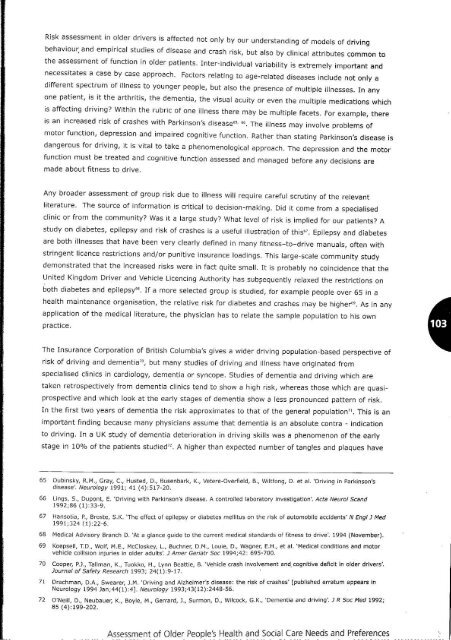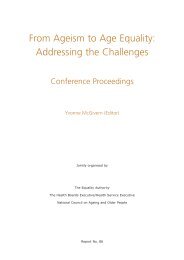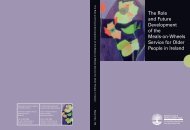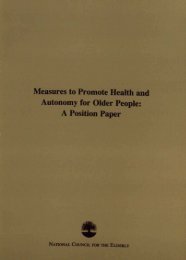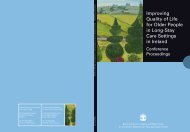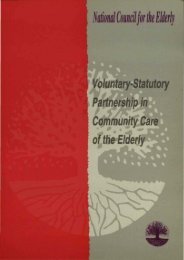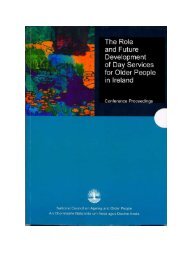Assessment of Older People's Health and Social Care Needs and ...
Assessment of Older People's Health and Social Care Needs and ...
Assessment of Older People's Health and Social Care Needs and ...
- No tags were found...
Create successful ePaper yourself
Turn your PDF publications into a flip-book with our unique Google optimized e-Paper software.
Risk assessment in older drivers is affected not only by our underst<strong>and</strong>ing <strong>of</strong> models <strong>of</strong> drivingbehaviour. <strong>and</strong> empirical studies <strong>of</strong> disease <strong>and</strong> crash risk, but also by clinical attributes common tothe assessment <strong>of</strong> function in older patients. Inter-individual variability is extremely important <strong>and</strong>necessitates a case by case approach.Factors relating to age-related diseases include not only adifferent spectrum <strong>of</strong> illness to younger people, but also the presence <strong>of</strong> multiple illnesses. In anyone patient, is it the arthritis, the dementia, the visual acuity or even the multiple medications whichis affecting driving? Within the rubric <strong>of</strong> one iilness there may be multiple facets. For example, thereis an increased risk <strong>of</strong> crashes with Parkinson's disease's. ". The illness may involve problems <strong>of</strong>motor function, depression <strong>and</strong> impaired cognitive function. Rather than stating Parkinson's disease isdangerous for driving, it is vital to take a phenomenological approach. The depression <strong>and</strong> the motorfunction must be treated <strong>and</strong> cognitive function assessed <strong>and</strong> managed before any decisions aremade about fitness to drive.Any broader assessment <strong>of</strong> group risk due to illness will require careful scrutiny <strong>of</strong> the relevantliterature. The source <strong>of</strong> information is critical to decision-making. Did it come from a specialisedclinic or from the community? Was it a large study? What level <strong>of</strong> risk is implied for our patients? Astudy on diabetes, epilepsy <strong>and</strong> risk <strong>of</strong> crashes is a useful illustration <strong>of</strong> this". Epilepsy <strong>and</strong> diabetesare both illnesses that have been very clearly defined in many fitness-to-drive manuals, <strong>of</strong>ten withstringent licence restrictions <strong>and</strong>/or punitive insurance loadings. This large-scale community studydemonstrated that the increased risks were in fact quite small. It is probably no coincidence that theUnited Kingdom Driver <strong>and</strong> Vehicle licencing Authority has sub?equently relaxed the restrictions onboth diabetes <strong>and</strong> epilepsy". If a more selected group is studied, for example people over 65 in ahealth maintenance organisation, the relative risk for diabetes <strong>and</strong> crashes may be higher'''. As in anyapplication <strong>of</strong> the medical literature, the physician has to relate the sample population to his ownpractice.The Insurance Corporation <strong>of</strong> British Columbia's gives a wider driving population-based perspective <strong>of</strong>risk <strong>of</strong> driving <strong>and</strong> dementia'·, but many studies <strong>of</strong> driving <strong>and</strong> illness have originated fromspecialised clinics in cardiology, dementia or syncope. Studies <strong>of</strong> dementia <strong>and</strong> driving which aretaken retrospectively from dementia clinics tend to show a high risk, whereas those which are quasiprospective<strong>and</strong> which look at the early stages <strong>of</strong> dementia show a less pronounced pattern <strong>of</strong> risk.In the first two years <strong>of</strong> dementia the risk approximates to that <strong>of</strong> the general population". This is animportant finding because many physicians assume that dementia is an absolute contra - indicationto driving. In a UK study <strong>of</strong> dementia deterioration in driving skills was a phenomenon <strong>of</strong> the earlystage in 10% <strong>of</strong> the patients studied". A higher than expected number <strong>of</strong> tangles <strong>and</strong> plaques have65 Dubinsky, R.M., Gray, C, Husted, D., Busenbark, K., Vetere-Overfield, B., Wiltfong, D. et al. 'Driving in Parkinson'sdisease'. Neurology 1991; 41 (4):517-20.66 Lings, S., Dupont, E. 'Driving with Parkinson's disease. A controlled laboratory investigation'. Acta Neurol Sc<strong>and</strong>1992;86 (1):33-9,67 Hansotia, P., Broste, S.K. 'The effect <strong>of</strong> epilepsy or diabetes mellitus on the risk <strong>of</strong> automobile accidents' N Engl J Med1991;324 (1):22-6.68 Medical Advisory Branch D. 'At a glance guide to the current medical st<strong>and</strong>ards <strong>of</strong> fitness to drive'. 1994 (November).69 Koepsell, T.D., Wolf, M.E., McCloskey, L, Buchner, D.M., Louie, D., Wagner, E.H., et al. 'Medical conditions <strong>and</strong> motorvehicle collision injuries in older adults'. J Amer Ger/atr Sac 1994;42: 695-700.70 Cooper, P.J., Tallman, K., Tuokko, H., Lynn Beattie, B. 'Vehicle crash involvement <strong>and</strong> cognitive deficit in older drivers'.Journal <strong>of</strong> Safety Research 1993; 24(1):9-17. .71 Drachman, D.A., Swearer, J.M. 'Driving <strong>and</strong> Alzheimer's disease: the risk <strong>of</strong> crashes' [published erratum appears inNeurology 1994 Jan;44(1):4). Neurology 1993;43(12):2448-56.72 O'Neill, D., Neubauer, K" Boyle, M" Gerrard, J., Surmon, D., Wilcock, G.K., 'Dementia <strong>and</strong> driving'. J R Sac Med 1992;85 (4):199-202.<strong>Assessment</strong> <strong>of</strong> <strong>Older</strong> <strong>People's</strong> <strong>Health</strong> <strong>and</strong> <strong>Social</strong> <strong>Care</strong> <strong>Needs</strong> <strong>and</strong> Preferences


